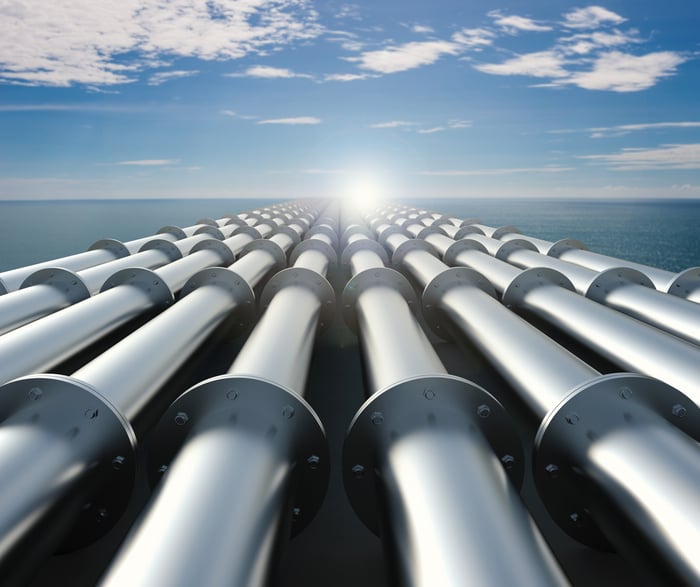TransCanada (TRP -0.56%) has completed 7 billion Canadian dollars' ($5.4 billion) worth of expansion projects over the past year, which, along with the strong performance from its legacy assets, helped drive solid earnings and cash-flow growth in the second quarter. The company currently has another CA$28 billion ($21.6 billion) of near-term growth projects and other investments under way, which gives it the confidence that its financial results will continue expanding at a fast pace over the next few years.
Drilling down into the numbers
|
Metric |
Q2 2018 |
Q2 2017 |
Year-Over-Year Change |
|---|---|---|---|
|
Comparable earnings before interest, taxes, depreciation, and amortization (EBITDA) |
$1.991 billion |
$1.830 billion |
8.8% |
|
Comparable distributable cash flow (DCF) |
$1.306 billion |
$1.181 billion |
10.6% |
|
DCF per share |
$1.46 |
$1.36 |
7.4% |
Data source: TransCanada Corporation. All figures in Canadian dollars. Current exchange rate 1 Canadian dollar = $0.77.
As that table shows, both earnings and cash flow increased by a healthy pace last quarter, driven mainly by the continued expansion of its U.S. natural gas pipelines business.

Data source: TransCanada Corporation. Chart by author.
Earnings in TransCanada's U.S. natural gas pipelines segment jumped nearly 28% year over year thanks to recently completed expansion projects on its Columbia system, additional contract sales on its ANR and Great Lakes pipelines, and improved pricing and volumes in its midstream assets.
TransCanada's liquids pipelines were also strong during the quarter, with earnings jumping more than 24% thanks to the recent completion of the Grand Rapids and Northern Courier pipelines and increased volumes on the Keystone Pipeline.
Finally, profitability in the Canadian natural gas pipeline segment increased 3% due to higher earnings on its NGTL system because of recently completed expansion projects.
Meanwhile, TransCanada saw slightly lower earnings from its natural gas pipelines in Mexico and a much larger decrease in its energy segment. That decline in energy earnings was due mainly to the sale of its U.S. Northeast Power and Ontario solar generation assets last year, both of which the company parted with to raise cash to invest in its expansion initiatives. TransCanada also recently announced the sale of its interest in the Cartier Wind power facilities for CA$630 million ($485 million) in cash, which will give it more money to finance its large slate of expansion projects.

Image source: Getty Images.
A look at what's coming down the pipeline
As mentioned, TransCanada currently has a significant number of growth projects under way to expand and improve its energy infrastructure portfolio. The company anticipates that these investments will generate 10% compound annual earnings growth through 2020, which should give it the fuel to boost its dividend by 8% to 10% per year through 2021.
In addition to those projects, the company has more than CA$20 billion ($15.4 billion) of longer-term projects in development, including the Keystone XL pipeline and Coastal GasLink. Both are moving closer toward starting construction. The U.S. State Department recently gave Keystone XL a positive environmental review, stating that the alternative route approved by regulators in Nebraska would have only minor to moderate effects on three of the eight categories it assessed. That puts the company one step closer to starting construction, which could begin next year.
Meanwhile, Royal Dutch Shell (RDS.A) (RDS.B) is working out the final details so that the company and its partners can officially approve the construction of LNG Canada, which would export natural gas from the country's west coast. Coastal GasLink would supply this facility with gas, which is why TransCanada is waiting for Shell's final approval before starting construction. Moving forward with these and other expansions in development "could extend our growth outlook beyond 2021," according to CEO Russ Girling.
Finally, TransCanada is still mulling over the options for its MLP TC Pipelines (TCP) in the wake of a policy revision that will affect that company's cash flows. That news hit TC Pipelines hard, with units tumbling more than 40% this year. Because of that, the MLP can't raise equity capital to fund drop-down acquisitions from TransCanada. While that's leading both companies to evaluate various options as they look to develop a new strategy, TransCanada made it clear that the company can still fund its expansion plan even without being able to sell assets to its MLP in the future.
The strategy is working as planned
TransCanada completed a large slate of expansion projects in the last year, which helped drive up earnings and cash flow in the second quarter, as expected. With several others expected to enter service this year, and even more on the way, the company is well positioned to generate steady growth over the next few years. That growing cash flow stream will give it the money to boost its high-yielding dividend at a healthy pace, which is what makes it an excellent income stock to buy for the long haul.





